How input - Enhanced authentic videos support english listening comprehension: A discussion from an interactionist perspective
With the light that literature has shed on the merits of authentic videos, this paper aims to
foreground two video input enhancement activities, namely annotating and captioning and argue
that when embedded in authentic videos, annotations and captions aid EFL learners’ vocabulary
acquisition and thus English listening comprehension. To this end, annotations and captions are
discussed on the theoretical grounds of Multimodality and the Interactionist Theory of Second
Language Acquisition (SLA). The paper concludes with implications for language teachers as to
the use of input-enhanced authentic videos for educational purposes in the listening classroom.
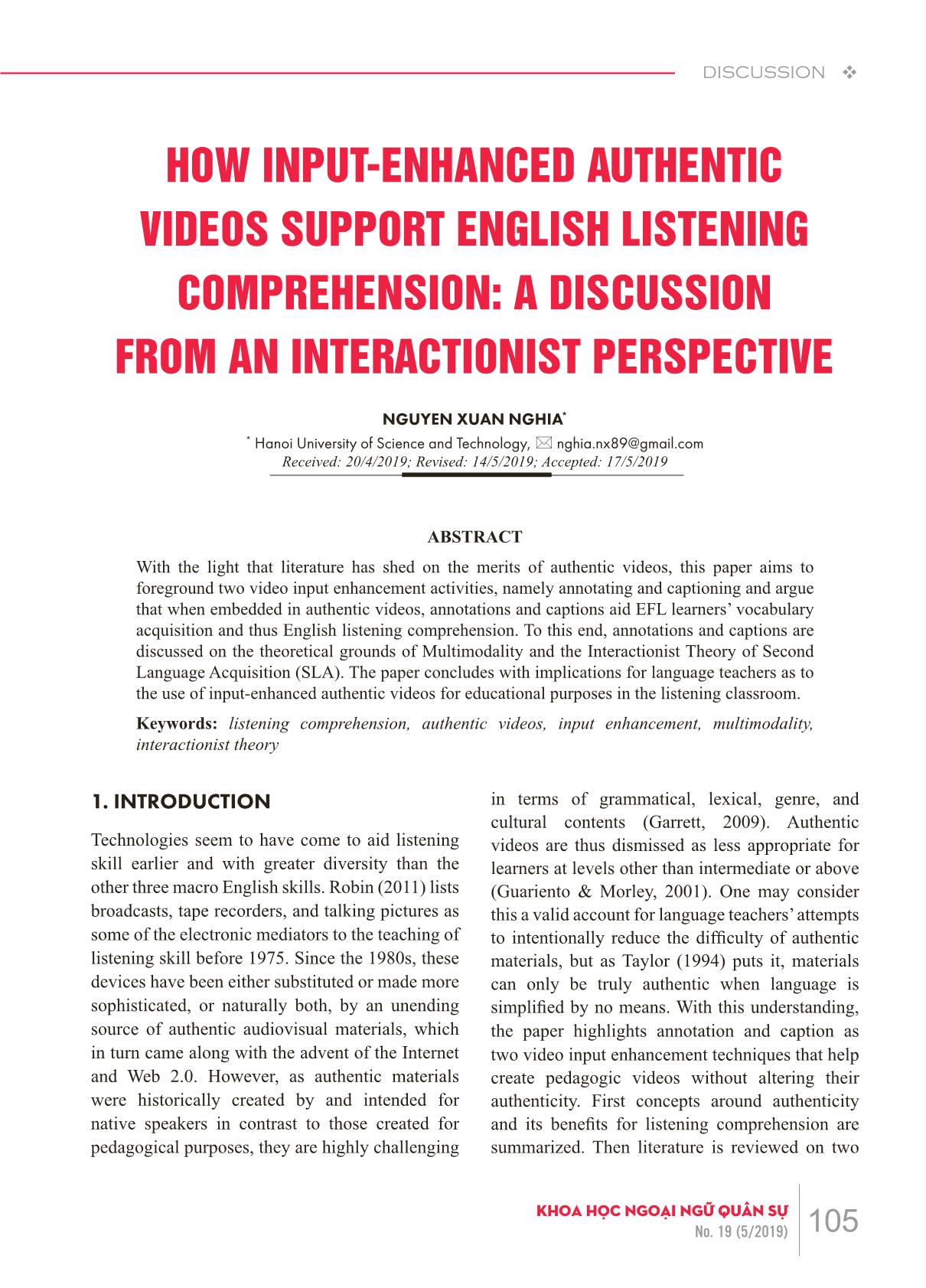
Trang 1
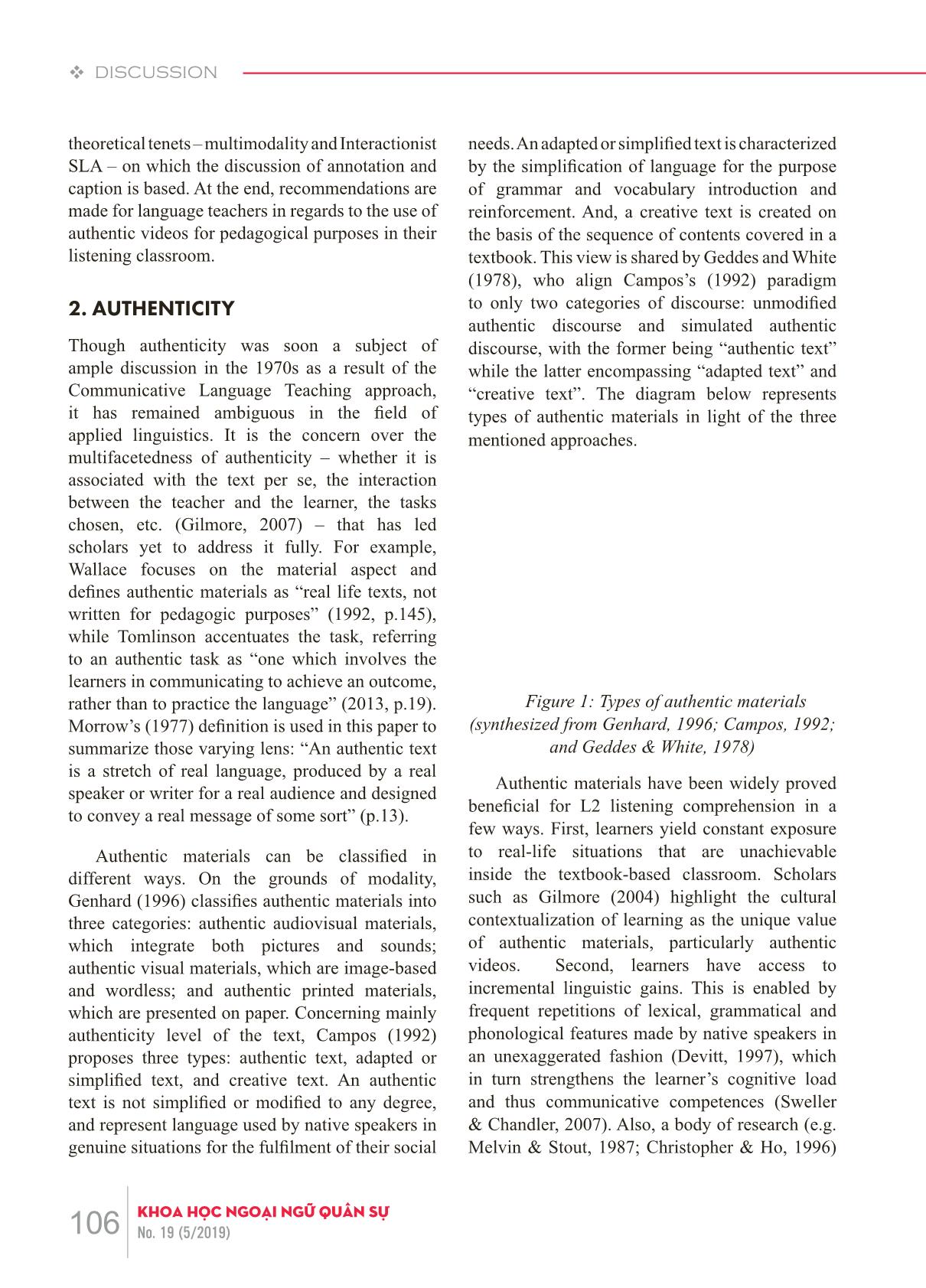
Trang 2
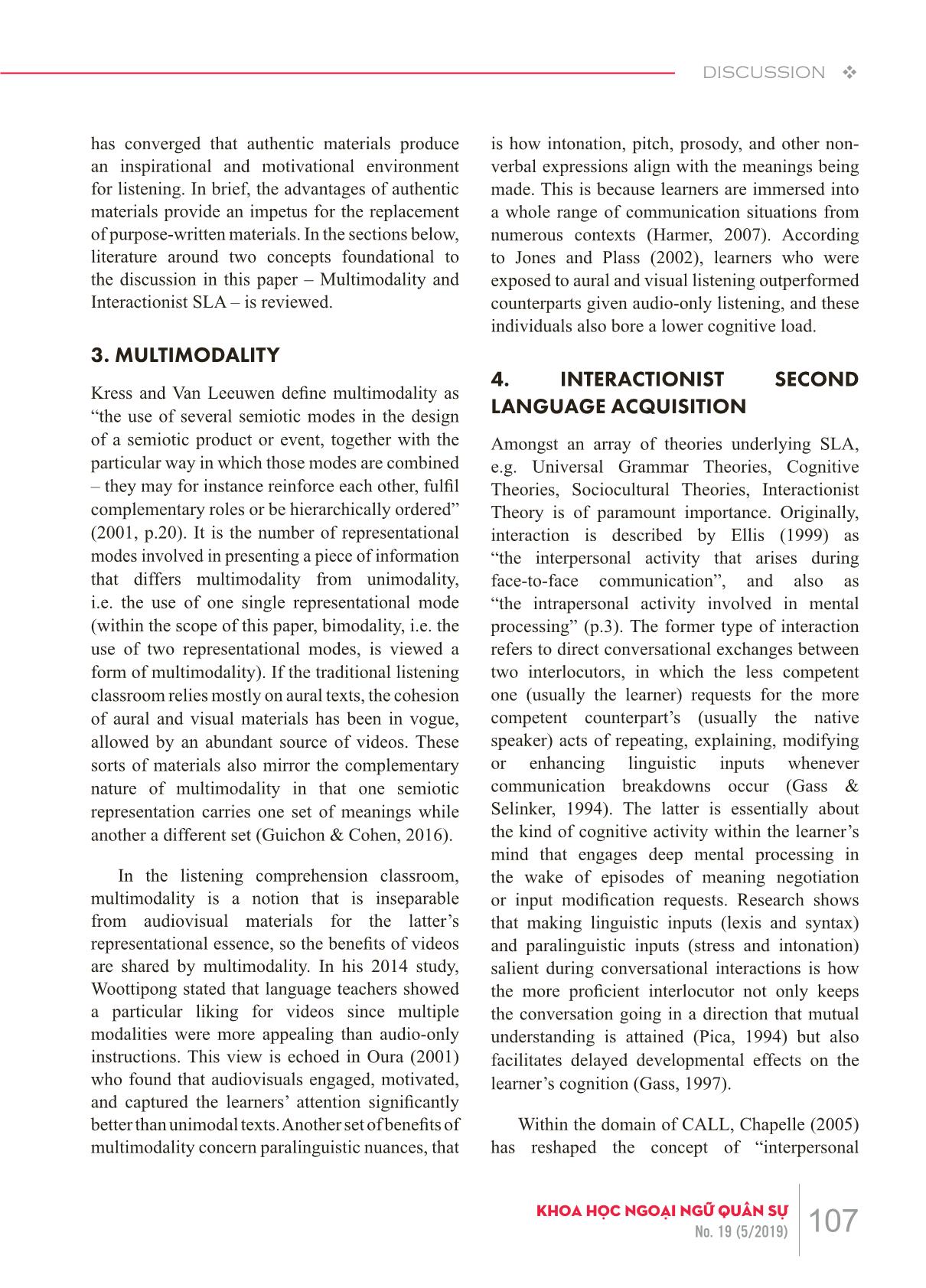
Trang 3
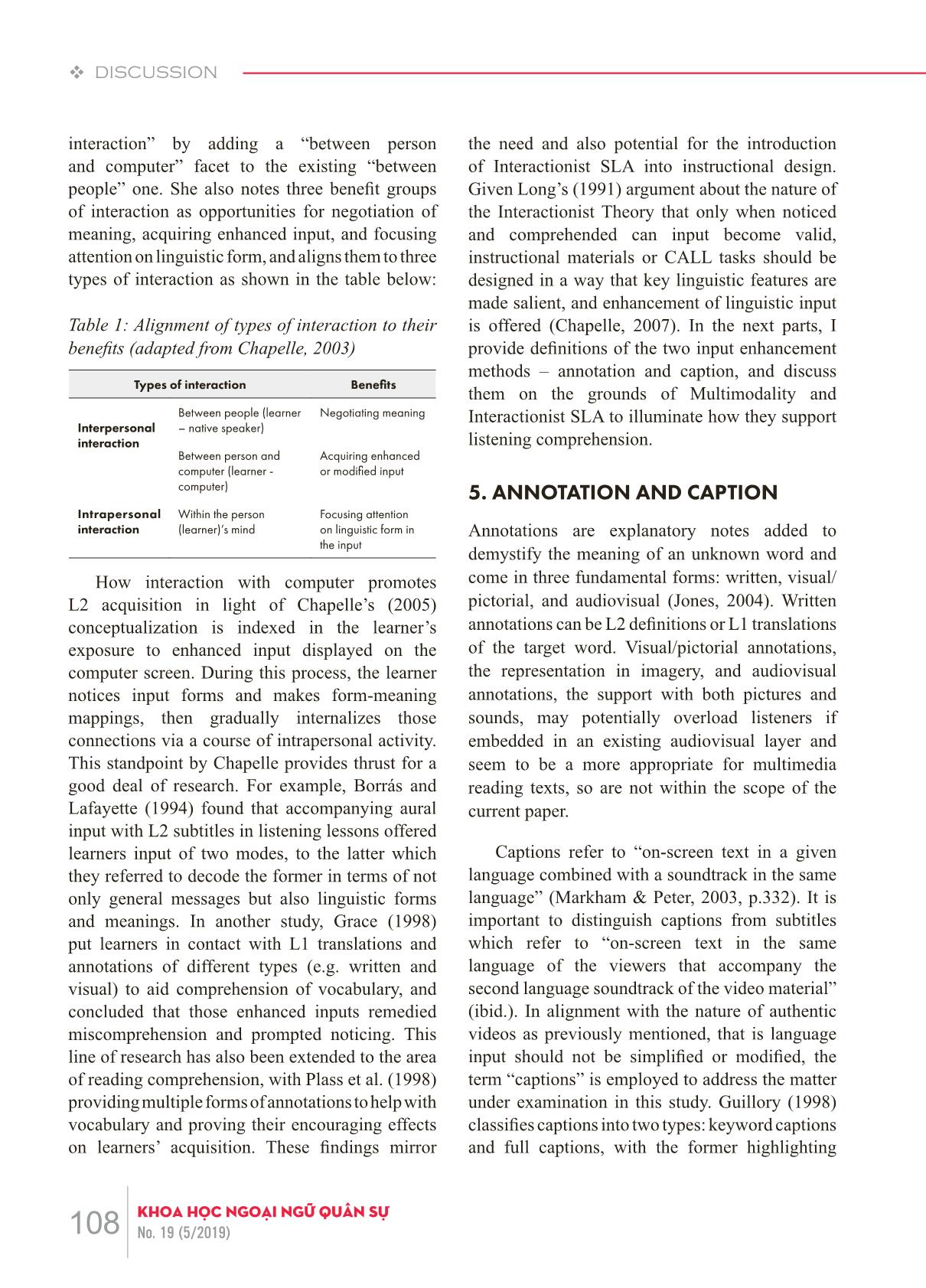
Trang 4
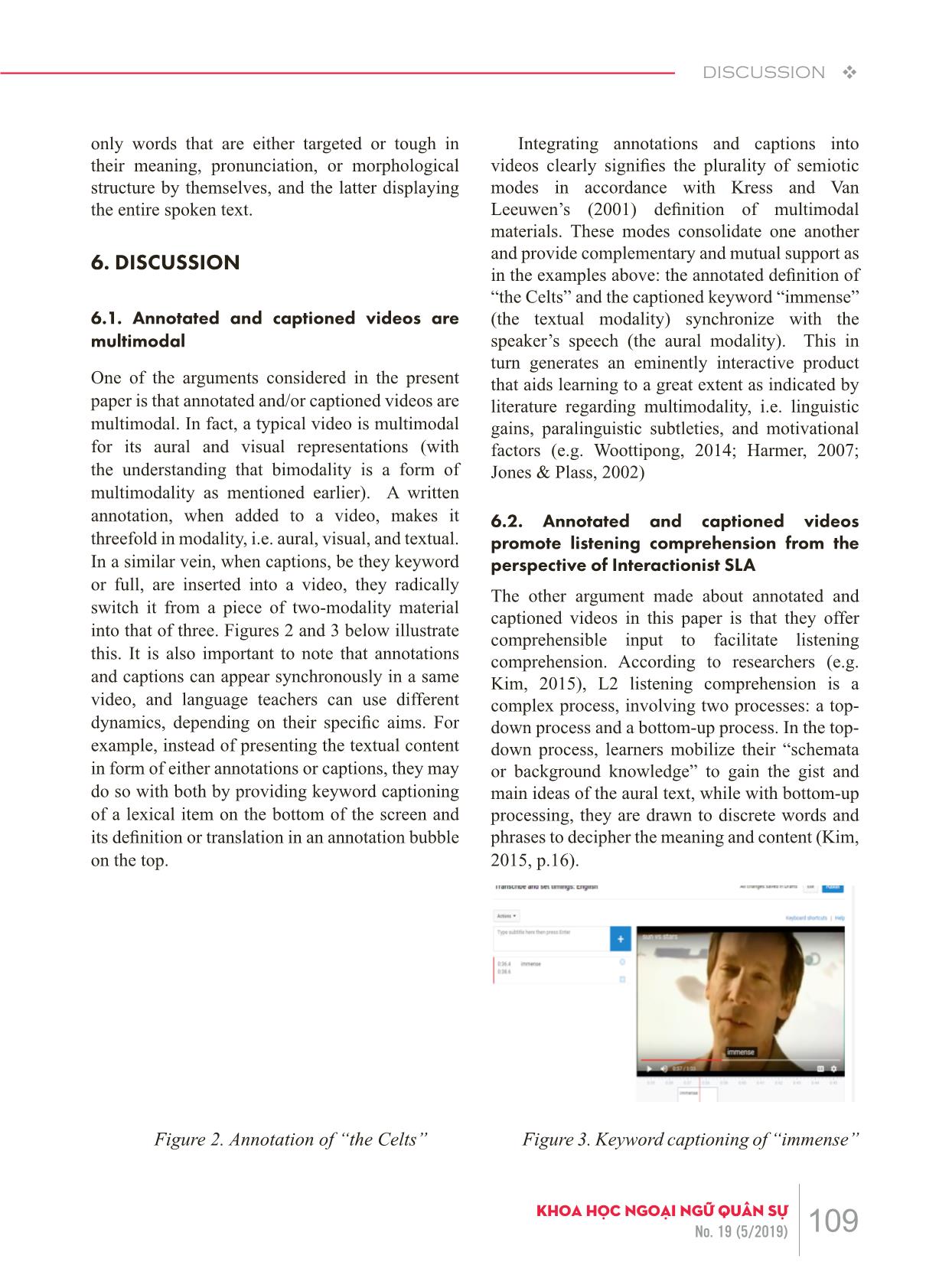
Trang 5
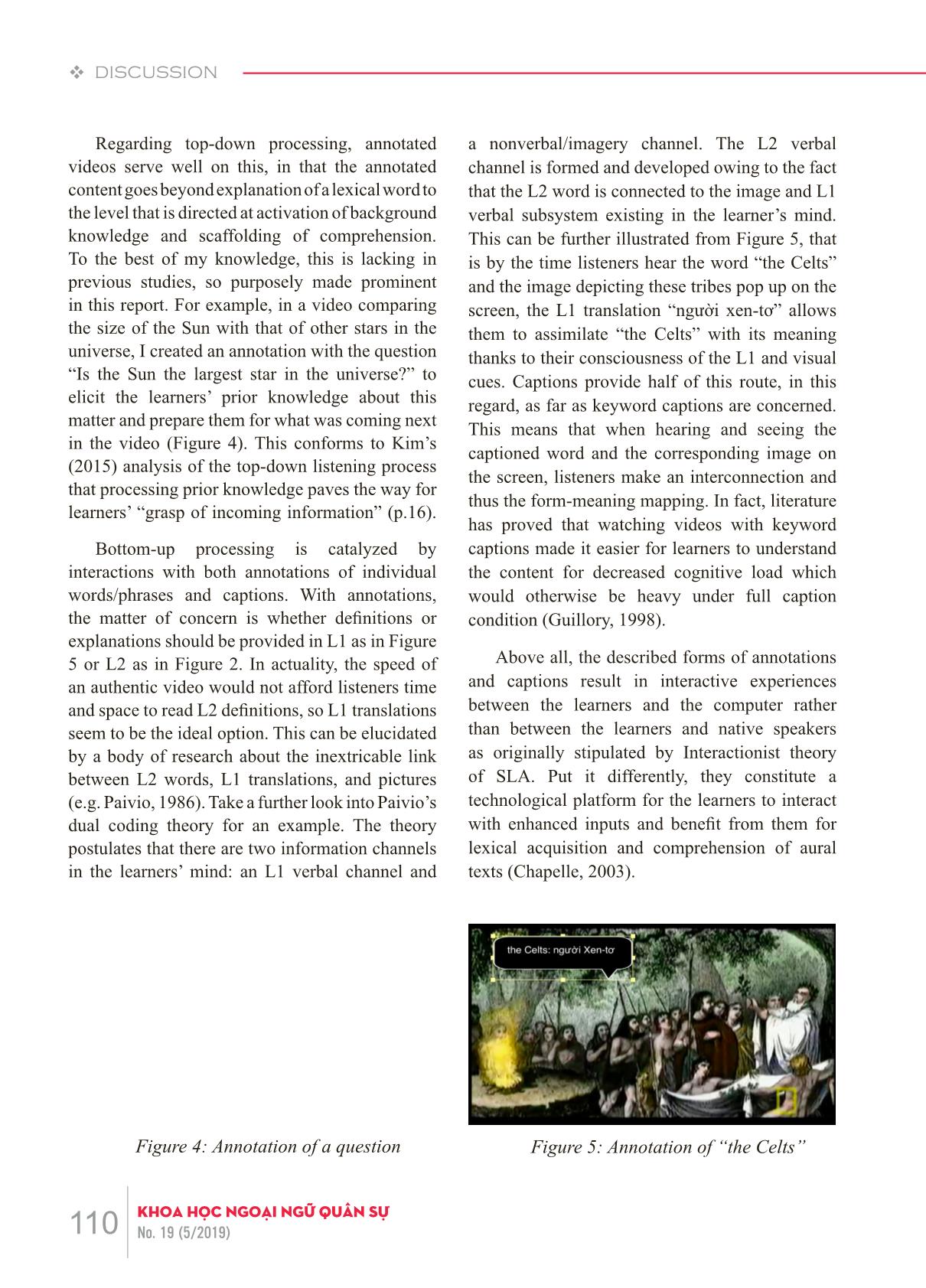
Trang 6
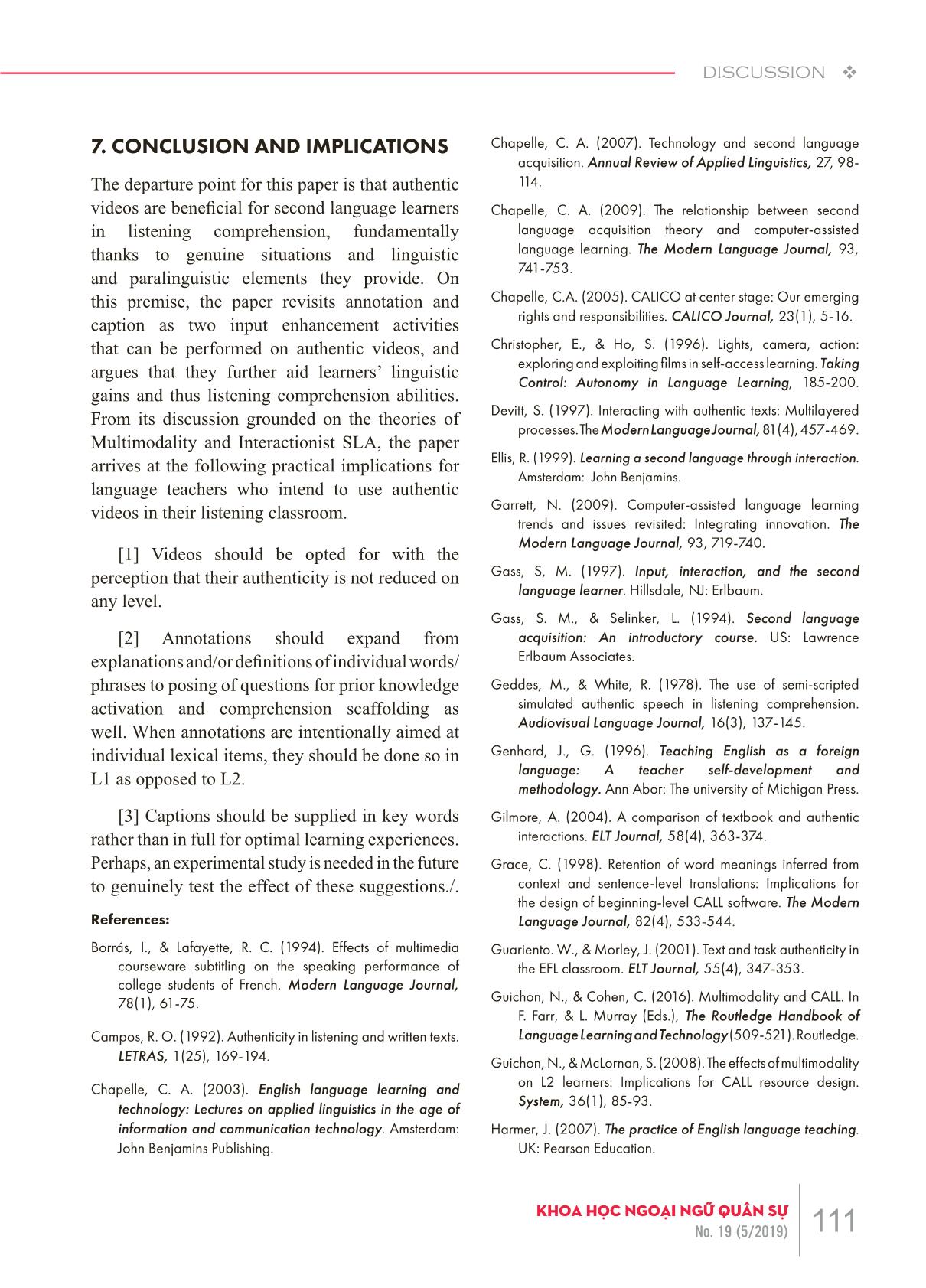
Trang 7
Bạn đang xem tài liệu "How input - Enhanced authentic videos support english listening comprehension: A discussion from an interactionist perspective", để tải tài liệu gốc về máy hãy click vào nút Download ở trên
Tóm tắt nội dung tài liệu: How input - Enhanced authentic videos support english listening comprehension: A discussion from an interactionist perspective
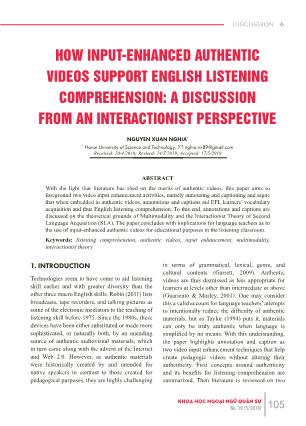
105KHOA HỌC NGOẠI NGỮ QUÂN SỰNo. 19 (5/2019) DISCUSSION v 1. INTRODUCTION Technologies seem to have come to aid listening skill earlier and with greater diversity than the other three macro English skills. Robin (2011) lists broadcasts, tape recorders, and talking pictures as some of the electronic mediators to the teaching of listening skill before 1975. Since the 1980s, these devices have been either substituted or made more sophisticated, or naturally both, by an unending source of authentic audiovisual materials, which in turn came along with the advent of the Internet and Web 2.0. However, as authentic materials were historically created by and intended for native speakers in contrast to those created for pedagogical purposes, they are highly challenging NGUYEN XUAN NGHIA* * Hanoi University of Science and Technology, nghia.nx89@gmail.com Received: 20/4/2019; Revised: 14/5/2019; Accepted: 17/5/2019 in terms of grammatical, lexical, genre, and cultural contents (Garrett, 2009). Authentic videos are thus dismissed as less appropriate for learners at levels other than intermediate or above (Guariento & Morley, 2001). One may consider this a valid account for language teachers’ attempts to intentionally reduce the difficulty of authentic materials, but as Taylor (1994) puts it, materials can only be truly authentic when language is simplified by no means. With this understanding, the paper highlights annotation and caption as two video input enhancement techniques that help create pedagogic videos without altering their authenticity. First concepts around authenticity and its benefits for listening comprehension are summarized. Then literature is reviewed on two ABSTRACT With the light that literature has shed on the merits of authentic videos, this paper aims to foreground two video input enhancement activities, namely annotating and captioning and argue that when embedded in authentic videos, annotations and captions aid EFL learners’ vocabulary acquisition and thus English listening comprehension. To this end, annotations and captions are discussed on the theoretical grounds of Multimodality and the Interactionist Theory of Second Language Acquisition (SLA). The paper concludes with implications for language teachers as to the use of input-enhanced authentic videos for educational purposes in the listening classroom. Keywords: listening comprehension, authentic videos, input enhancement, multimodality, interactionist theory HOW INPUT-ENHANCED AUTHENTIC VIDEOS SUPPORT ENGLISH LISTENING COMPREHENSION: A DISCUSSION FROM AN INTERACTIONIST PERSPECTIVE 106 KHOA HỌC NGOẠI NGỮ QUÂN SỰNo. 19 (5/2019) v DISCUSSION theoretical tenets – multimodality and Interactionist SLA – on which the discussion of annotation and caption is based. At the end, recommendations are made for language teachers in regards to the use of authentic videos for pedagogical purposes in their listening classroom. 2. AUTHENTICITY Though authenticity was soon a subject of ample discussion in the 1970s as a result of the Communicative Language Teaching approach, it has remained ambiguous in the field of applied linguistics. It is the concern over the multifacetedness of authenticity – whether it is associated with the text per se, the interaction between the teacher and the learner, the tasks chosen, etc. (Gilmore, 2007) – that has led scholars yet to address it fully. For example, Wallace focuses on the material aspect and defines authentic materials as “real life texts, not written for pedagogic purposes” (1992, p.145), while Tomlinson accentuates the task, referring to an authentic task as “one which involves the learners in communicating to achieve an outcome, rather than to practice the language” (2013, p.19). Morrow’s (1977) definition is used in this paper to summarize those varying lens: “An authentic text is a stretch of real language, produced by a real speaker or writer for a real audience and designed to convey a real message of some sort” (p.13). Authentic materials can be classified in different ways. On the grounds of modality, Genhard (1996) classifies authentic materials into three categories: authentic audiovisual materials, which integrate both pictures and sounds; authentic visual materials, which are image-based and wordless; and authentic printed materials, which are presented on paper. Concerning mainly authenticity level of the text, Campos (1992) proposes three types: authentic text, adapted or simplified text, and creative text. An authentic text is not simplified or modified to any degree, and represent language used by native speakers in genuine situations for the fulfilment of their social needs. An adapted or simplified text is characterized by the simplification of language for the purpose of grammar and vocabulary introduction and reinforcement. And, a creative text is created on the basis of the sequence of contents covered in a textbook. This view is shared by Geddes and White (1978), who align Campos’s (1992) paradigm to only two categories of discourse: unmodified authentic discourse and simulated authentic discourse, with the former being “authentic text” while the latter encompassing “adapted text” and “creative text”. The diagram below represents types of authentic materials in light of the three mentioned approaches. Figure 1: Types of authentic materials (synthesized from Genhard, 1996; Campos, 1992; and Geddes & White, 1978) Authentic materials have been widely proved beneficial for L2 listening comprehension in a few ways. First, learners yield constant exposure to real-life situations that are unachievable inside the textbook-based classroom. Scholars such as Gilmore (2004) highlight the cultural contextualization of learning as the unique value of authentic mat ... in the person (learner)’s mind Focusing attention on linguistic form in the input How interaction with computer promotes L2 acquisition in light of Chapelle’s (2005) conceptualization is indexed in the learner’s exposure to enhanced input displayed on the computer screen. During this process, the learner notices input forms and makes form-meaning mappings, then gradually internalizes those connections via a course of intrapersonal activity. This standpoint by Chapelle provides thrust for a good deal of research. For example, Borrás and Lafayette (1994) found that accompanying aural input with L2 subtitles in listening lessons offered learners input of two modes, to the latter which they referred to decode the former in terms of not only general messages but also linguistic forms and meanings. In another study, Grace (1998) put learners in contact with L1 translations and annotations of different types (e.g. written and visual) to aid comprehension of vocabulary, and concluded that those enhanced inputs remedied miscomprehension and prompted noticing. This line of research has also been extended to the area of reading comprehension, with Plass et al. (1998) providing multiple forms of annotations to help with vocabulary and proving their encouraging effects on learners’ acquisition. These findings mirror the need and also potential for the introduction of Interactionist SLA into instructional design. Given Long’s (1991) argument about the nature of the Interactionist Theory that only when noticed and comprehended can input become valid, instructional materials or CALL tasks should be designed in a way that key linguistic features are made salient, and enhancement of linguistic input is offered (Chapelle, 2007). In the next parts, I provide definitions of the two input enhancement methods – annotation and caption, and discuss them on the grounds of Multimodality and Interactionist SLA to illuminate how they support listening comprehension. 5. ANNOTATION AND CAPTION Annotations are explanatory notes added to demystify the meaning of an unknown word and come in three fundamental forms: written, visual/ pictorial, and audiovisual (Jones, 2004). Written annotations can be L2 definitions or L1 translations of the target word. Visual/pictorial annotations, the representation in imagery, and audiovisual annotations, the support with both pictures and sounds, may potentially overload listeners if embedded in an existing audiovisual layer and seem to be a more appropriate for multimedia reading texts, so are not within the scope of the current paper. Captions refer to “on-screen text in a given language combined with a soundtrack in the same language” (Markham & Peter, 2003, p.332). It is important to distinguish captions from subtitles which refer to “on-screen text in the same language of the viewers that accompany the second language soundtrack of the video material” (ibid.). In alignment with the nature of authentic videos as previously mentioned, that is language input should not be simplified or modified, the term “captions” is employed to address the matter under examination in this study. Guillory (1998) classifies captions into two types: keyword captions and full captions, with the former highlighting 109KHOA HỌC NGOẠI NGỮ QUÂN SỰNo. 19 (5/2019) DISCUSSION v only words that are either targeted or tough in their meaning, pronunciation, or morphological structure by themselves, and the latter displaying the entire spoken text. 6. DISCUSSION 6.1. Annotated and captioned videos are multimodal One of the arguments considered in the present paper is that annotated and/or captioned videos are multimodal. In fact, a typical video is multimodal for its aural and visual representations (with the understanding that bimodality is a form of multimodality as mentioned earlier). A written annotation, when added to a video, makes it threefold in modality, i.e. aural, visual, and textual. In a similar vein, when captions, be they keyword or full, are inserted into a video, they radically switch it from a piece of two-modality material into that of three. Figures 2 and 3 below illustrate this. It is also important to note that annotations and captions can appear synchronously in a same video, and language teachers can use different dynamics, depending on their specific aims. For example, instead of presenting the textual content in form of either annotations or captions, they may do so with both by providing keyword captioning of a lexical item on the bottom of the screen and its definition or translation in an annotation bubble on the top. Integrating annotations and captions into videos clearly signifies the plurality of semiotic modes in accordance with Kress and Van Leeuwen’s (2001) definition of multimodal materials. These modes consolidate one another and provide complementary and mutual support as in the examples above: the annotated definition of “the Celts” and the captioned keyword “immense” (the textual modality) synchronize with the speaker’s speech (the aural modality). This in turn generates an eminently interactive product that aids learning to a great extent as indicated by literature regarding multimodality, i.e. linguistic gains, paralinguistic subtleties, and motivational factors (e.g. Woottipong, 2014; Harmer, 2007; Jones & Plass, 2002) 6.2. Annotated and captioned videos promote listening comprehension from the perspective of Interactionist SLA The other argument made about annotated and captioned videos in this paper is that they offer comprehensible input to facilitate listening comprehension. According to researchers (e.g. Kim, 2015), L2 listening comprehension is a complex process, involving two processes: a top- down process and a bottom-up process. In the top- down process, learners mobilize their “schemata or background knowledge” to gain the gist and main ideas of the aural text, while with bottom-up processing, they are drawn to discrete words and phrases to decipher the meaning and content (Kim, 2015, p.16). Figure 2. Annotation of “the Celts” Figure 3. Keyword captioning of “immense” 110 KHOA HỌC NGOẠI NGỮ QUÂN SỰNo. 19 (5/2019) v DISCUSSION Regarding top-down processing, annotated videos serve well on this, in that the annotated content goes beyond explanation of a lexical word to the level that is directed at activation of background knowledge and scaffolding of comprehension. To the best of my knowledge, this is lacking in previous studies, so purposely made prominent in this report. For example, in a video comparing the size of the Sun with that of other stars in the universe, I created an annotation with the question “Is the Sun the largest star in the universe?” to elicit the learners’ prior knowledge about this matter and prepare them for what was coming next in the video (Figure 4). This conforms to Kim’s (2015) analysis of the top-down listening process that processing prior knowledge paves the way for learners’ “grasp of incoming information” (p.16). Bottom-up processing is catalyzed by interactions with both annotations of individual words/phrases and captions. With annotations, the matter of concern is whether definitions or explanations should be provided in L1 as in Figure 5 or L2 as in Figure 2. In actuality, the speed of an authentic video would not afford listeners time and space to read L2 definitions, so L1 translations seem to be the ideal option. This can be elucidated by a body of research about the inextricable link between L2 words, L1 translations, and pictures (e.g. Paivio, 1986). Take a further look into Paivio’s dual coding theory for an example. The theory postulates that there are two information channels in the learners’ mind: an L1 verbal channel and a nonverbal/imagery channel. The L2 verbal channel is formed and developed owing to the fact that the L2 word is connected to the image and L1 verbal subsystem existing in the learner’s mind. This can be further illustrated from Figure 5, that is by the time listeners hear the word “the Celts” and the image depicting these tribes pop up on the screen, the L1 translation “người xen-tơ” allows them to assimilate “the Celts” with its meaning thanks to their consciousness of the L1 and visual cues. Captions provide half of this route, in this regard, as far as keyword captions are concerned. This means that when hearing and seeing the captioned word and the corresponding image on the screen, listeners make an interconnection and thus the form-meaning mapping. In fact, literature has proved that watching videos with keyword captions made it easier for learners to understand the content for decreased cognitive load which would otherwise be heavy under full caption condition (Guillory, 1998). Above all, the described forms of annotations and captions result in interactive experiences between the learners and the computer rather than between the learners and native speakers as originally stipulated by Interactionist theory of SLA. Put it differently, they constitute a technological platform for the learners to interact with enhanced inputs and benefit from them for lexical acquisition and comprehension of aural texts (Chapelle, 2003). Figure 4: Annotation of a question Figure 5: Annotation of “the Celts” 111KHOA HỌC NGOẠI NGỮ QUÂN SỰNo. 19 (5/2019) DISCUSSION v 7. CONCLUSION AND IMPLICATIONS The departure point for this paper is that authentic videos are beneficial for second language learners in listening comprehension, fundamentally thanks to genuine situations and linguistic and paralinguistic elements they provide. On this premise, the paper revisits annotation and caption as two input enhancement activities that can be performed on authentic videos, and argues that they further aid learners’ linguistic gains and thus listening comprehension abilities. From its discussion grounded on the theories of Multimodality and Interactionist SLA, the paper arrives at the following practical implications for language teachers who intend to use authentic videos in their listening classroom. [1] Videos should be opted for with the perception that their authenticity is not reduced on any level. [2] Annotations should expand from explanations and/or definitions of individual words/ phrases to posing of questions for prior knowledge activation and comprehension scaffolding as well. When annotations are intentionally aimed at individual lexical items, they should be done so in L1 as opposed to L2. [3] Captions should be supplied in key words rather than in full for optimal learning experiences. Perhaps, an experimental study is needed in the future to genuinely test the effect of these suggestions./. References: Borrás, I., & Lafayette, R. C. (1994). Effects of multimedia courseware subtitling on the speaking performance of college students of French. Modern Language Journal, 78(1), 61-75. Campos, R. O. (1992). Authenticity in listening and written texts. LETRAS, 1(25), 169-194. Chapelle, C. A. (2003). English language learning and technology: Lectures on applied linguistics in the age of information and communication technology. Amsterdam: John Benjamins Publishing. Chapelle, C. A. (2007). Technology and second language acquisition. Annual Review of Applied Linguistics, 27, 98- 114. Chapelle, C. A. (2009). The relationship between second language acquisition theory and computer-assisted language learning. The Modern Language Journal, 93, 741-753. Chapelle, C.A. (2005). CALICO at center stage: Our emerging rights and responsibilities. CALICO Journal, 23(1), 5-16. Christopher, E., & Ho, S. (1996). Lights, camera, action: exploring and exploiting films in self-access learning. Taking Control: Autonomy in Language Learning, 185-200. Devitt, S. (1997). Interacting with authentic texts: Multilayered processes. The Modern Language Journal, 81(4), 457-469. Ellis, R. (1999). Learning a second language through interaction. Amsterdam: John Benjamins. Garrett, N. (2009). Computer-assisted language learning trends and issues revisited: Integrating innovation. The Modern Language Journal, 93, 719-740. Gass, S, M. (1997). Input, interaction, and the second language learner. Hillsdale, NJ: Erlbaum. Gass, S. M., & Selinker, L. (1994). Second language acquisition: An introductory course. US: Lawrence Erlbaum Associates. Geddes, M., & White, R. (1978). The use of semi-scripted simulated authentic speech in listening comprehension. Audiovisual Language Journal, 16(3), 137-145. Genhard, J., G. (1996). Teaching English as a foreign language: A teacher self-development and methodology. Ann Abor: The university of Michigan Press. Gilmore, A. (2004). A comparison of textbook and authentic interactions. ELT Journal, 58(4), 363-374. Grace, C. (1998). Retention of word meanings inferred from context and sentence-level translations: Implications for the design of beginning-level CALL software. The Modern Language Journal, 82(4), 533-544. Guariento. W., & Morley, J. (2001). Text and task authenticity in the EFL classroom. ELT Journal, 55(4), 347-353. Guichon, N., & Cohen, C. (2016). Multimodality and CALL. In F. Farr, & L. Murray (Eds.), The Routledge Handbook of Language Learning and Technology (509-521). Routledge. Guichon, N., & McLornan, S. (2008). The effects of multimodality on L2 learners: Implications for CALL resource design. System, 36(1), 85-93. Harmer, J. (2007). The practice of English language teaching. UK: Pearson Education.
File đính kèm:
 how_input_enhanced_authentic_videos_support_english_listenin.pdf
how_input_enhanced_authentic_videos_support_english_listenin.pdf

